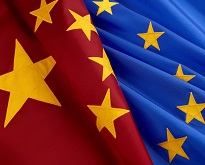In 2019, China was the third largest partner for EU exports of goods (9% of total extra-EU exports) and largest for EU imports of goods (19% of total extra-EU imports).
During the period 2009 to 2019, the EU had a trade in goods deficit (meaning larger imports than exports) with China, which varied between €104 billion and €164 billion. In 2019 the trade deficit stood at €164 billion.
Source dataset: ext_st_eu27_2019sitc and DS-018995
For both EU exports and imports of goods with the China, 'machinery and vehicles', 'chemicals' and 'other manufactured goods' dominate. Together these manufactured goods accounted for 87% of EU exports of goods to China and 97% of EU imports of goods from China.
Among the Member States, the Netherlands was the largest importer of goods (€88 billion) from China and Germany was the largest exporter of goods (€96 billion) to China in 2019.
Note:
- The European Union (EU) includes 27 EU Member States. The United Kingdom left the European Union on 31 January 2020. Further information is published here.
- The EU 27 data reflect the political change in the EU composition so the UK is considered as an extra-EU partner country for the EU27. However, the UK is still part of the internal market until the end of the transitory period, meaning that data on trade with the UK are still based on statistical concepts applicable to trade between the EU Member States. As a consequence, while imports from any other extra-EU27 trade partner are grouped by country of origin, the UK data reflect country of consignment. In practice this means that the goods imported by the EU27 from the UK were physically transported from the UK but part of these goods could have been of other origin than the UK. For this reason data on trade with the UK are not fully comparable with data on trade with other extra-EU27 trade partners like China.
- Trade data: Due to quasi-transit trade, the adding of intra-EU trade and extra-EU trade may lead to double counting. An example of this would be goods imported from China via the Netherlands, where they are cleared by customs for free circulation, before being dispatched to Germany. This would lead to the same goods being counted as imports by both the Netherlands and Germany. More precisely, they would appear in the Netherlands' extra-EU imports from China and intra-EU exports to Germany and in Germany's intra-EU imports from the Netherlands.
For further information:
- Statistics Explained article China-EU international trade in goods statistics
- Overview of statistics on international trade in goods
To contact us, please visit our User Support page.
For press queries, please contact our Media Support.


